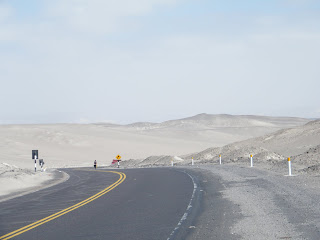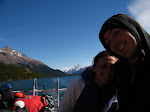We left off last in Puno, where we planned to stay just a night before hitting the final 400kms to Cusco. Unfortunately I got struck down by a nasty virus that left me bed-ridden for five days. Watching four hours of back to back Friends re-runs and staring at the same box-like hotel room nearly sent me over the edge. Puno is not a great town, there´s precisely nothing to do there and by day three Ben was bored stiff of eating on his own and then spending the rest of the day stuck in a tiny hotel room with me watching said re-runs of Friends. We had two options - spend another four days in Puno recovering and then have less time in Cusco or get a bus to Cusco and cycle the costal route into Lima instead. Another four days in Puno was beyond comprehension but after five days in bed with no food trying to cycle 400kms at high altitude seemed impossible. So, it was with heavy hearts that we loaded our things onto a rickety old bus for the 8 hour ride to Cusco. It was a particularly unpleasant bus ride; bumpy, smelly and all the time we were wishing that we could have been cycling the spectacularly scenic route. We consoled ourselves with the thought that we could still end our trip cycling the Panamerican highway along the southern coast and hopefully find some interesting spots along the way.
A couple of days relaxing in beautiful Cusco was the perfect remedy. Our visit coincided with the big Choquekillka celebrations so the streets were filled with dancers from all over the country in traditional dress. After a few days soaking up the sights of the city, watching the celebrations and even managing to find a few home comforts like baked beans and marmite we decided we couldn`t come to Cusco and miss out on Machu Picchu.
The machete dance ... not remotely threatening
There are only two ways to get to Machu Picchu - hike the Inca Trail or take the expensive Peru Rail train to Aguas Calientes and then walk the last 3kms up to the site or take a bus. If you want to do the Inca Trail you need to book at least 6 months in advance and be willing to part with 200 dollars. Plus I`ve heard that the whole thing is littered with bog roll anyway. Also I met a girl in Puno who told me in great detail how she`d really 'left her mark´on the Inca trail after eating some dodgy food in Cusco. So we parted with an extraordinary amount of money to travel exactly 22kms on a train that somehow took 2 hours and made the pilgrimage to Aguas Calientes. Our plan was to wake up before dawn and trek the last 3kms up to Machu Picchu to try and get there while the ten thousand other tourists were either still gorging themselves on hotel breakfast buffets or waiting for the bus to heave them up the mountain. We got up at 4am and after a few wrong turns and scrabbling around in the dark we finally found the right trail and started the steep climb up the mountain. It was beautiful seeing the mountains slowly appearing in the dawn light and after a fairly gruelling hour of climbing we arrived at the top panting and sweating. As we watched the sun rising over the ruins and lighting up the ancient city it made the early start worth it. By 10am the whole place was crammed full of tourists, sweltering hot and it took forever to shuffle from one side to another getting tangled up in tour groups and tripping over idiotic hiking poles so we made a swift exit and headed back to Aguas Calientes to start the tedious journey back to Cusco.
Sunrise over Machu Picchu
Back in Cusco we prepared ourselves for the onward journey. We needed to get on a bus to reach Nazca, a desert town in southern Peru, from where we planned to get back on our bikes for the last stretch to Lima. The road between Cusco and Nazca is notorioulsy dangerous and apparently many tourist buses have been hijacked along the road so we decided that cycling it wasn`t the best idea. It does also explain why we were forced to provide fingerprints and were videoed as we got on the bus. Luckily we got to Nazca safely and managed to fit in an overflight over the famous and mysterious Nazca lines.
Lima 420km ... lawlessness and violence 117km
After our quick stop off in Nazca we jumped back on the bikes and spent the day cycling through the desert marvelling at the huge sand dunes. We arrived in Palpa a small town 60kms north of Nazca in time for lunch and decided to spend the day there. Our next stop was Ica another 100kms along the Panamerican. We were confident that we`d make it in a day as we thought it would be flat desert.
We weren`t really bargaining on having to climb over a big pass first thing in the morning. Being back down at 400metres above sea level as opposed to 4000metres made the long climb seem like a breeze though, and it was fun actually being able to breathe again. Luckily the rest of the ride was gently rolling and with a helpful back wind we made it to the outskirts of Ica by early afternoon. We were actually heading for a small town called Huacachina 5km outside Ica, a desert lagoon surrounded by huge sand dunes that sounded like a good place to stop for a night or two. Our rubbish map suggested that to get to Huacachina you actually had to go into Ica and thanks to a total lack of road signs on the Panamerican that`s exactly what we did. Big mistake. Not only is Ica a total crap hole it`s also swarming with theiving bastards who dragged me off my bike, stole my bag and then threatened Ben with a knife. It was 3pm on a busy street and noone even blinked an eyelid. Luckily I had my money and passport stashed in my fanny pack! Turns out muggings are pretty common in Ica, especially on Sundays because none of the police want to take the Sunday afternoon shift. Actually it seems they´re pretty reluctant to take any shift, we watched one "on duty" policeman in Huacachina watch 6 hours of solid football while his assistant dozed in an armchair.
The lagoon at Huacachina
So all in all it hasn´t been the most magnificent end to what has been a brilliant trip but we should count ourselves lucky that in 6 months this is the only real setback we´ve had. Mostly we have met with the most incredible kindness; from Jorge the man that lets cyclists stay at his house for free to Jackie the kindly lady that loaded us into her old Chevy when we got blown off the road, we have met so many generous, helpful and a good helping of truly bonkers people. We have cycled on some terrible roads passed some of the most spectacular scenery and fought against wind, rain and burning desert heat. More than once I´ve questioned why the hell we were doing it to ourselves and thrown my bike down in a fit of desperation and more than once I´ve wanted to DHL the damn thing home and slip into a 180 degree reclining seat on a bus but looking back now I´d do anything to start it all over again.
Our flight home leaves tomorrow morning and the bikes are all boxed up and ready to go. It seems like yesterday that we were battling the winds in Tierra del Fuego and now we´re heading home a lot fitter, a bit beaten up but with happy memories of our time pedalling for Peru.
Finally made it to the beach


























